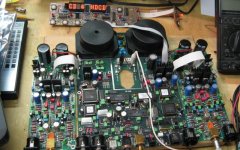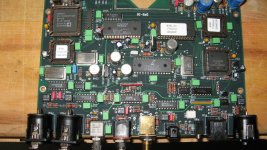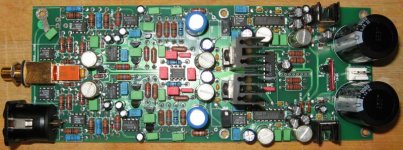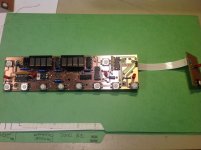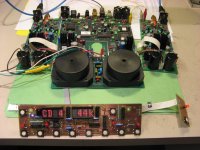I got a set of ML36 DAC PCB's for some work I did. I want to build this DAC to match my ML37 transport. However, I didn't have any schematics with it. I managed to make the ML36 up and running. I built cables, found the correct PCB's interconnect and AC supply voltage selection jumpers, drawn part of the schematic, etc...). It was some little work, but it is working perfectly. If you zoom on the display PCB, it is showing HDCD decoding, playing a HDCD cd as expected 😀
It was just great that my ML38 control PCB was directly compatible with the ML36. Just plug and play...
Scarry picture isn't
😱
By the way, if any of you got the schematics for this DAC, send me an email.
It was just great that my ML38 control PCB was directly compatible with the ML36. Just plug and play...
Scarry picture isn't
😱
By the way, if any of you got the schematics for this DAC, send me an email.
Attachments
I have an orginal ML36 front panel that I bought from PD two years ago. I should receive a casing to mount it in a few month from Peter Van Casteren. I have also original replica of the feet from my previous ML38 pcb project.
I had a nice rear panel plate made for it while I had a batch of ML38 back plates mades. It still has its protective film. Just need some drilling. It is has nice as an original ML product.
I had a nice rear panel plate made for it while I had a batch of ML38 back plates mades. It still has its protective film. Just need some drilling. It is has nice as an original ML product.
Attachments
I'm planning to upgrade the digital receiver IC CS8412 to CS8416 that is reported better sounding and pin compatible. It is also using the very good PMD100 HDCD filter chip. One of the very nice digital IC's in my book. Too bad Microsoft destroyed this Cie as well as some many others...
This is a very sophisticated DAC, with 6 diigital inputs that can be routed to a digital output as well. All inputs are transformer coupled. A rolling buffer and re-clocking reduce jitter effect. Separate clock modules for different digital sections.
Here a view of the digital section.
This is a very sophisticated DAC, with 6 diigital inputs that can be routed to a digital output as well. All inputs are transformer coupled. A rolling buffer and re-clocking reduce jitter effect. Separate clock modules for different digital sections.
Here a view of the digital section.
Attachments
The DAC audio section is completely dual mono, fully balanced. The DAC audio amplifier is a replica of the ML38 preamp power output section using the excellent EL2020/2010 (MAT02,03) buffers.
The DAC is using two PCM1702 DAC IC's per channel, BB OPA2604 op-amp, Vishay RN60D film resistors, Wima and ROE caps all around, low drop out regulators and low ESR caps. Numerous separate voltage regs, etc...
I won't debate that better DAC exists now. I probably have a few.
I just can't wait to try it with a good transport. I'm using a cheap Rotel CD player for now on my test bed. To have a matching DAC with my ML380 and ML37 will be just great. I'll use the ST fiber optic digital link. Best interconnect link I ever tried.
It would cost a fortune in money and time just to try to build such a DAC from scratch. Here the one of the DAC PCB.
You know, toys for boys
The DAC is using two PCM1702 DAC IC's per channel, BB OPA2604 op-amp, Vishay RN60D film resistors, Wima and ROE caps all around, low drop out regulators and low ESR caps. Numerous separate voltage regs, etc...
I won't debate that better DAC exists now. I probably have a few.
I just can't wait to try it with a good transport. I'm using a cheap Rotel CD player for now on my test bed. To have a matching DAC with my ML380 and ML37 will be just great. I'll use the ST fiber optic digital link. Best interconnect link I ever tried.
It would cost a fortune in money and time just to try to build such a DAC from scratch. Here the one of the DAC PCB.
You know, toys for boys

Attachments
I always admired the #36 DAC. Remarkably good sound. I would like to know what's inside their clock modules.
Display boards
Is it possible to have a description of the interface between the main board and the display module?
Regards
Is it possible to have a description of the interface between the main board and the display module?
Regards
interface between the main board and the display module is exactly the same as the ML38 preamp. In fact I was able to use my own ML38 control PCB directly. It is a serial bus with clock with I/O multiplexed into the serial stream. The processor interface on the bus using a PAL.
Very basis stuff for these days, but high tech for the 80's.
Send me an email, I can send you the ML38 schematics, you'll see all the details...
jwb, their clock modules seems to be temperature compensated clock, same type used into high accuracy frequency counter from the same period. I know I used to calibrate and repair them. These modules are claimed to be low jitter, as Tent Audio clocks.
Very basis stuff for these days, but high tech for the 80's.
Send me an email, I can send you the ML38 schematics, you'll see all the details...
jwb, their clock modules seems to be temperature compensated clock, same type used into high accuracy frequency counter from the same period. I know I used to calibrate and repair them. These modules are claimed to be low jitter, as Tent Audio clocks.
- Status
- Not open for further replies.
- Home
- Source & Line
- Digital Source
- Building Mark Levinson ML36 DAC chassis from scratch
